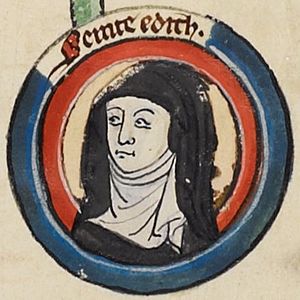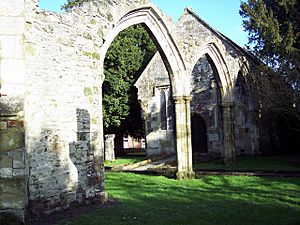Wulfthryth of Wilton facts for kids
Wulfthryth, also called Wilfrida (died around the year 1000), was a significant figure in the life of Edgar, King of England in the early 960s. Some historians believe she was his wife, while others think she was his partner. Their daughter, Edith, became known as a saint in the 1000s. Around 964, King Edgar married another woman named Ælfthryth. At that time, or perhaps earlier, Wulfthryth returned to Wilton Abbey, a religious community where she had grown up, taking her daughter Edith with her. Wulfthryth stayed at Wilton Abbey for the rest of her life, eventually becoming its leader, known as the Abbess. She passed away on September 21st, around the year 1000. People at Wilton Abbey considered her a saint, but her fame did not spread much beyond that area.
Who Was Wulfthryth?
We know about Wulfthryth from several old writings and records. These include stories about saints, chronicles (historical accounts), and official documents from King Edgar. These ancient texts describe her as living a very good and holy life. Her good qualities were often compared to the more complicated actions of King Edgar's later wife, Ælfthryth.
Wulfthryth's Life Story
Wulfthryth was an English noblewoman, born around 937. She was a relative of Wulfhild. King Edgar of England brought her from the nunnery (a place where nuns live) at Wilton Abbey to his home in Kemsing. While in Kent, Wulfthryth gave birth to their daughter, Edith.
Some historical writers, like Goscelin and William of Malmesbury, say that Edgar married Wulfthryth. However, they also say that she decided to leave the marriage soon after Edith was born. Edith was then dedicated to a religious life at Wilton Abbey as a baby. Her mother, Wulfthryth, followed her there shortly after.
After at least a year, Wulfthryth returned to Wilton Abbey, bringing Edith with her. She later became the head of the abbey, known as the Abbess, and lived longer than her daughter. According to scholar Katie Ann-Marie Bugyis, Wulfthryth showed how much a woman could achieve as a leader in a monastery. Her experience as a mother did not stop her from becoming a successful Abbess. The community did not see her having been a mother as a problem for her leadership.
According to old religious texts, King Edgar performed penance (a way to show sorrow for a wrongdoing) for his actions, guided by Saint Dunstan. As part of this penance, Edgar did not wear his crown for seven years. He also gave Wulfthryth six estates (large pieces of land) in Wiltshire and the Isle of Wight. She then gave these lands to Wilton Abbey in 965 AD.
Historians have different ideas about Wulfthryth's relationship with Edgar. Some call her his partner, while others call her his second wife. It seems Edgar accepted Edith as his daughter. The relationship might have been seen as a marriage, even without a formal church blessing, which was sometimes the custom back then. If so, Edith was considered a legitimate daughter.
Wulfthryth continued to have a lot of influence on King Edgar even after she returned to Wilton. For example, she was able to stop officials from arresting a thief who had found sanctuary (protection) in the Abbey. She also managed to get two Wilton priests released from prison.
As Abbess of Wilton, she had a stone wall built around the Abbey. She also used her wealth to collect many relics (holy objects) for the abbey. Goscelin called her the "hidden treasure and light" of the Abbey. She was highly respected during her life and was believed to have performed miracles and given a lot of Alms (charity).
A Saintly Figure
Both Wulfthryth and her daughter Edith were considered saints after they passed away. Wulfthryth died at Wilton on September 21st, most likely in the year 1000. She was buried in front of the main altar of the Wilton Abbey church.
Her special day, or Feast Day, is celebrated on September 13th.



